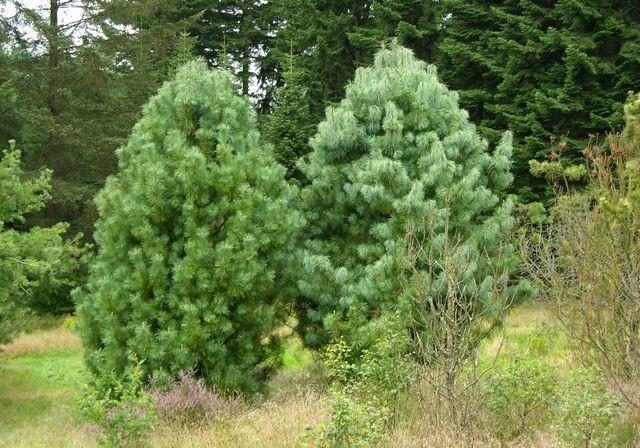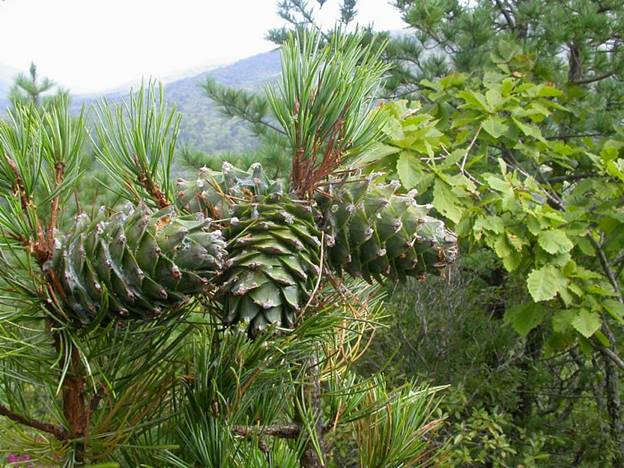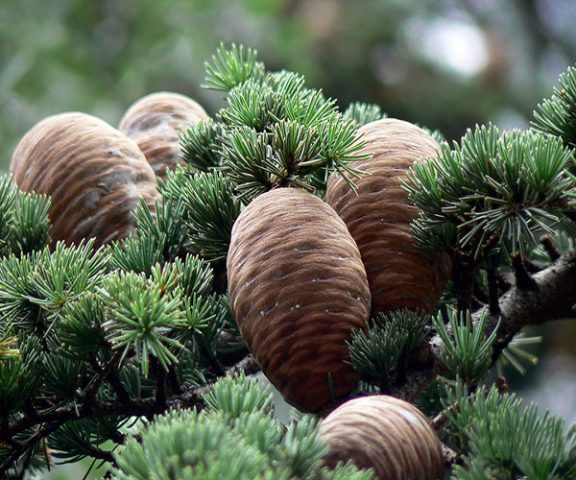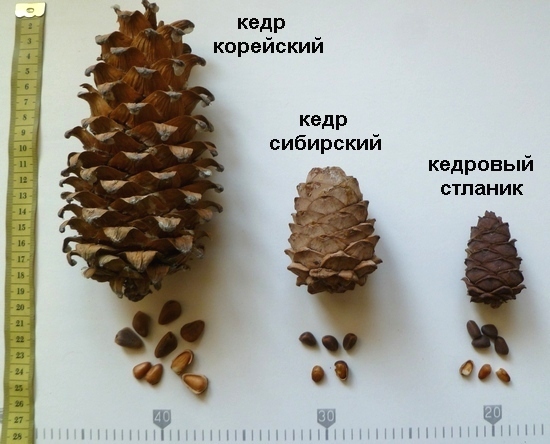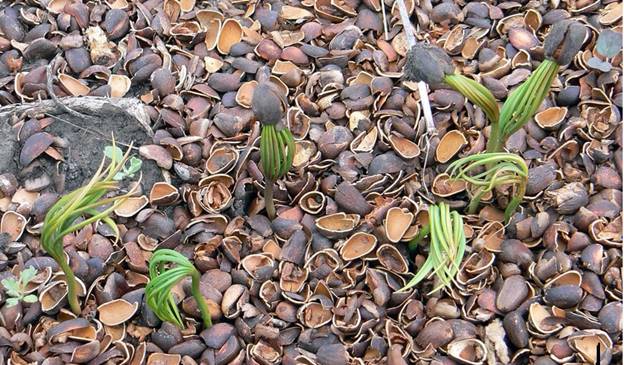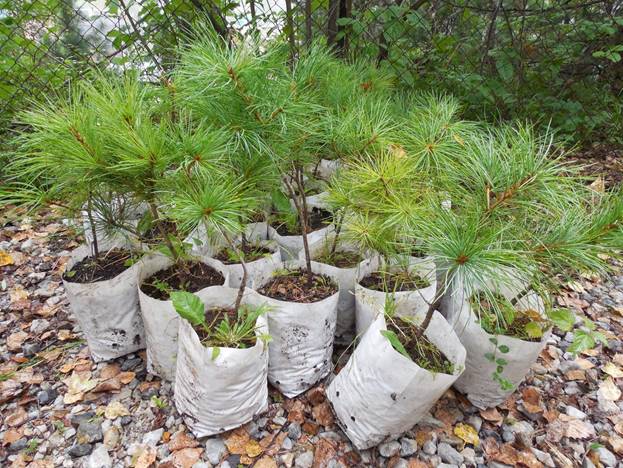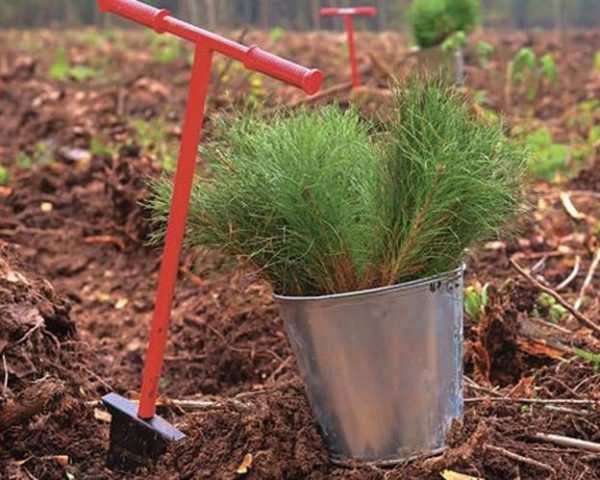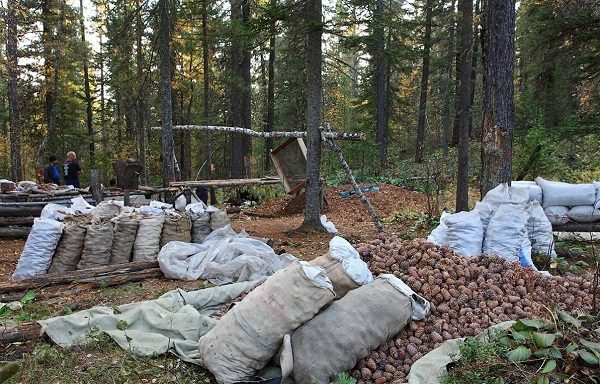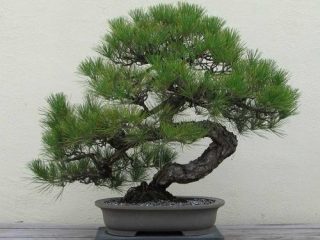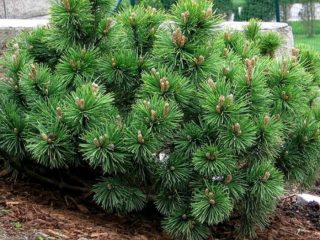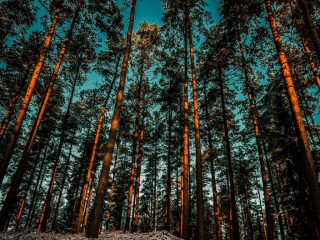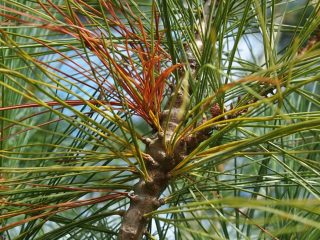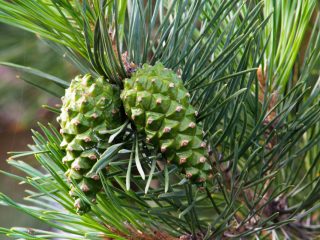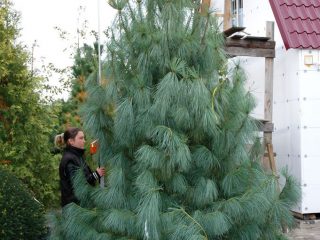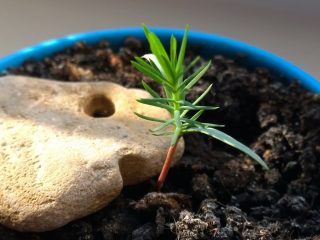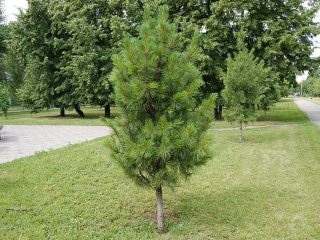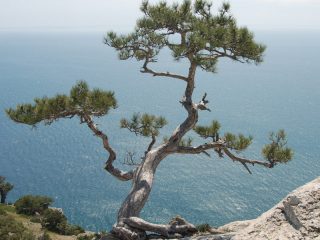Content
Korean or Manchurian cedar grows in Primorye, Amur region and Khabarovsk region. Outside Russia, it is distributed in northeast China, central Japan and Korea. Due to its valuable wood, the crop has been almost completely exterminated in China, but for the Amur region it is protected and listed in the Red Book.
How to distinguish cedar pine from cedar
In fact, Korean cedar is not cedar at all. It doesn't even belong to the genus Cedrus. Its full botanical name is Korean Cedar Pine (Pinus koraiensis), and it belongs to the large and diverse genus Pine. Such confusion in the Russian language arose a long time ago, and it seems that no one is particularly confused.
Korean cedar nuts (which, by the way, are not nuts in the botanical sense), unlike real seeds, are edible and are a valuable food and medicinal product. Cedrus and Pinus, although they belong to the same family - Pine, but have a lot of differences:
- Korean cedar grows in temperate and cold climates, but real cedar is very thermophilic;
- Pines have roots that go deep into the ground, while cedars spread them widely and can be uprooted by a strong wind;
- the needles of Korean cedar are long, can reach 20 cm, while the needles of real cedar grow to a maximum of 5 cm;
- real cedar needles are collected in bunches of 40 pieces, Korean ones - 5 each;
- the cones of these crops are very different from each other;
- The seeds of the cedar pine are edible, covered with a hard peel, which is why they really look like nuts, while in the cedar they are much smaller, with a thin shell, and are also equipped with a large wing.
There are other differences, but to recognize the culture, just look at the needles or cone.
There are four types of cedar pines:
- Korean;
- Siberian;
- European;
- Stlanikovaya.
All of them have edible nuts and are only distantly related to the true cedar.
True cedar (Cedrus), in turn, includes three types:
- Atlas;
- Lebanese;
- Himalayan.
Korean pine:
Lebanese cedar:
Description of Korean cedar
Korean pine pine is an evergreen coniferous tree up to 40 m high with a multi-peaked, low-hanging crown in the shape of a wide cone. The ends of the outstretched branches are raised up, the bark is thick, smooth, dark gray or gray-brown. Young shoots are brown, with a reddish edge.
The average length of the bluish-green hard needles with blunt ends is 7-15 cm, the maximum is 20 cm. Triangular needles are collected together in groups of 5 and live for 2-4 years.
In May, yellow or pale pink male microstrobili located inside the crowns bloom on Korean cedar. Female cones form at the tops of large branches. During flowering they are beige or pale pink, after fertilization they turn green, at the end of summer they turn light brown and remain that way until next spring. At the beginning of the second growing season, the cones begin to actively grow and turn green again. After ripening, they turn beige or light brown.
The size of ripe Korean pine cones is up to 18 cm long (individuals up to 23 cm), diameter is about 6-9 cm. The shape resembles an elongated egg with scales bent outward. The seeds, incorrectly called pine nuts, reach 1.8 cm in length with a maximum diameter of 1 cm.
The cones ripen in the fall, a year and a half after pollination. Some of them fall off, some remain hanging until spring. Fruiting begins at 25-30 years, the lifespan of Korean cedar is up to 600 years.
Differences between Siberian and Korean pine cones
Various sources pay sadly little attention to the description of the cones of various cedar pines. Three species are widespread in Russia - Korean, Siberian and Stlanikovaya. And although they are very different from each other, lovers can easily recognize only the last type - dwarf cedar. It is a small tree or shrub that bends its branches to the ground and forms impenetrable thickets.
The other two pines are not only confused, but also often include photographs and descriptions of the Siberian pine in articles about Korean cedar. You need to distinguish them:
- Mature cones of Korean pine are twice as large as those of Siberian pine.
- Korean cedar seeds reach a length of 18 mm, Siberian cedar - a maximum of 12 mm.
- During flowering, Korean cedar cones are beige, and during ripening they are green. Siberian has raspberry and purple colors, respectively.
- Korean cedar cones ripen in October, Siberian cedar - by August.
The difference between cones and seeds is easy to see in the photo of Korean, Siberian and dwarf cedar.
Varieties of Korean pine pine
Cedar pines look attractive, but they are too large for small areas. Therefore, selection is aimed not so much at breeding varieties with an original crown shape or bright needles, but at reducing the size of the tree.
Korean cedar Sulange
This is not a variety, but a variety of Korean pine pine. A tree up to 40 m tall with long (up to 20 cm) bluish-green needles begins to bear fruit in the 15-20th year of life. The crown is dense, openwork. Sulange tolerates air pollution much better than the main species, which allows it to be grown in city parks. Fruiting, which begins 10 years earlier than that of ordinary Korean cedar, is of great economic importance.
Korean silver pine
Silveray is an ornamental variety with a pyramidal crown and long, slightly curved needles with a silver-blue tint. By the age of ten, the tree reaches a height of 250 cm, with a diameter of 120 cm, increasing by 25 cm annually.
The variety is characterized by high frost resistance, is demanding on soil fertility and does not tolerate stagnation of water at the roots.
Korean cedar Morris Blue
This variety was bred in Pennsylvania and is highly frost-resistant. Forms a dense conical crown with silver-blue needles collected in groups of 5. During the season, the growth is 15-20 cm. An adult Korean cedar Maurice Blue grows up to 3.5 m with a crown width of 1.8 m.
The bark is gray and looks especially attractive in winter. It does not tolerate urban conditions well, requires a sunny location, does not tolerate stagnation of water in the root area, but tolerates drought quite well. Lives up to 120 years.
Korean cedars of Russian selection
In the post-Soviet space, the Tomsk enterprise Siberian Academy of Trees and Shrubs LLC has been breeding Korean cedars for more than 20 years. They created the Blue Amur variety, distinguished by blue needles and a height of 4 m.
In the Far East, breeder Alexander Simonenko is engaged in Korean pine pine. Two dwarf early-fruiting varieties are currently being tested in the Tomsk nursery: Patriarch and Svyatoslav.
Unfortunately, it is almost impossible to buy Russian cultivars - they are sold out on the spot, not allowing them to reach even two years of age.
Growing Korean cedar from seeds
Before planting Korean cedar seeds, you should take into account that varieties can only be propagated by grafting. Their nuts will grow into tall species plants, unsuitable for decorating a small area. For planting Korean cedars in order to obtain a harvest, the seeds of plus trees, that is, the best ones, are better suited. To do this, choose the largest cones with large scales.
Sowing seeds in autumn
From late September to early November, Korean pine seeds are sown without stratification. Germination will be 91%, whereas with spring planting it will be 76%.The seeds are first soaked for 3-4 days in a 0.5% solution of potassium permanganate and sown on ridges in rows spaced 10-15 cm apart.
They are planted to a depth of 3-4 cm and first mulched and then covered with spruce branches. This will not only protect the soaked seeds from freezing in winter, but will also protect them from mice and birds. The sowing rate is 200 pieces per linear meter - cedar pine seedlings are not afraid of thickening.
Spring sowing
When sowing Korean pine seeds in the spring, stratification must be carried out. Ideally, this takes 80-90 days. The seeds are soaked in a solution of citric acid and heteroauxin for 3-4 days, placed in a box with wet sawdust or sand and left outside under the snow.
But what if the planting material was purchased in the spring? Soak the seeds in warm water for 6-8 days, changing it every 2 days. Then mix with washed sand and leave at room temperature. Korean cedar seeds will hatch in about a month or a little more.
They are immediately placed in the refrigerator or transferred to a room with a temperature close to 0 ° C, where they are stored until planting in the ground.
Seeds that have been treated at low temperatures are sown on ridges in late April or early May in the same way as in the fall.
Further care of seedlings
In the spring, in order to prevent birds from pecking at the seedlings, the ridges are covered with a transparent film, which is removed only after the shells fall off. Cedar pines are picked very early, in the cotyledon state, and even better before they open. Then the survival rate will be about 95%.
Before planting in a permanent place, seedlings are transplanted into shrublets several times. It is best to perform the operation in the spring, but if necessary it can be done in the fall. First, three-year-old cedar pines are planted at a distance of 30-35 cm in rows spaced 1 m apart. After 3-5 years, they are transferred to a new school and placed according to a 1x1 m pattern.
All this time, the cedars are moderately watered, fed and protected from the midday sun. Coniferous litter is added to the soil of the seedlings - this makes the seedlings grow faster.
Planting in open ground and care
There should not be any particular difficulties when planting Korean cedar. It is important to choose a high-quality seedling and a place for it - mature pines do not tolerate moving well. To get a good harvest, at least two trees must grow nearby.
Selection and preparation of a landing site
Korean cedar prefers acidic, moderately fertile soils, rich in humus and permeable to water and air. They grow well in rocky soils, are tolerant of strong winds and tolerate shade when young. Over time, pines become very light-loving.
Korean cedars can grow in areas with groundwater standing more than 1.5 m - their root system is powerful, goes deep into the ground, and does not tolerate soaking. When preparing the site, the roots of weeds are removed from the soil; stones, if any, are left.
The planting pit should be quite spacious - about 1-1.5 m deep and with a diameter.To prepare the nutrient mixture, the top layer of soil is mixed with 3-5 buckets of leaf humus, acidic peat and at least 20 liters of coniferous litter.
All these additives acidify the soil and make it loose, permeable to air and water. If the groundwater is close, the hole is made deeper and drainage is poured onto the bottom - gravel, broken red brick.
Preparation of planting material
It is best to immediately plant large-sized Korean pine trees - ten-year-old trees above 80 cm. But they are quite expensive, and at least two copies are needed to get a harvest. Therefore, many gardeners are forced to buy small seedlings. Their only advantage over large-sized ones (besides price) is ease of planting.
Container plants are watered the day before moving into open ground. Dug up seedlings should be purchased with a large earthen ball, protected with damp burlap or film. It is recommended to plant them as quickly as possible.
Landing rules
Korean cedar pines planted for decorative purposes can be placed at a distance of 4 m from each other. To ensure good fruiting, the minimum gap between trees is 6-8 m. If space allows, it is better to increase the distance to 10-12 m.
Before planting Korean pine pine, the pre-dug planting hole is completely filled with water, having previously been filled 1/3 with a fertile mixture. When the moisture is absorbed:
- Fertile soil is added to the bottom so that the root collar is flush with the edge of the hole.
- Korean cedar is installed in the center.
- The planting hole is gradually filled with a fertile mixture and compacted.
- Check and, if necessary, correct the position of the root collar.
- Korean cedar is watered abundantly.
- The tree trunk circle is mulched with acidic peat or coniferous litter.
Watering and fertilizing
Great importance is attached to feeding and watering cedar pine in the first 10 years of its life. Then fertilizers are replaced by mulching, and watering is carried out several times during the summer if the weather is dry.
Care for a young plant must be thorough. For fertilizing, it is best to use special fertilizers for conifers. They are produced separately for each season, maintaining the balance of substances necessary for the tree, and are used 3 times during the growing season. If it is not possible to use special fertilizers, give the usual ones:
- in spring, after the snow melts - with a predominance of nitrogen;
- at the beginning of summer - a full mineral complex;
- in the middle or end of August - phosphorus-potassium (without nitrogen).
Throughout the entire growing season, it is useful for Korean cedar, like other coniferous crops, to be given foliar feeding. To do this, it is better to use chelate complexes and magnesium sulfate.
Watering of young cedar pines is carried out as the soil dries out. It is better to skip watering than to allow water to stagnate in the root area.
Pruning and shaping Korean cedar
Pruning is not included in the care package for Korean cedar. In early spring or autumn, only dry branches are removed. Formative pruning is not carried out at all.
Preparing for winter
Korean cedars are covered for the winter only in the first year after planting. This is a winter-hardy crop that can withstand low temperatures well. The seedlings are wrapped in white agrofibre or spandbond and secured with twine.
Productivity of Korean cedar
Korean cedar pines grown from seeds begin to bear fruit 25-30 years after germination, while grafted ones sometimes take several years.In natural conditions, trees often produce crops only after 60 years.
The cones ripen at the end of October, the next year after pollination. Each contains from 100 to 160 seeds weighing 0.5-0.6 g, with the kernel making up 35-40% of the weight of the “nut”.
Korean cedar pine cones grow in groups, and only on the tops of trees; only some can be located on branches adjacent to the crown. On young specimens, the seeds are usually larger than on older ones.
Under favorable conditions, Korean cedar reaches maximum fruiting at 100-170 years. It lasts up to 350-450 years. Good harvests are harvested every 3-4 years, but a complete absence of fruits is almost never observed. In a good year, one mature tree produces up to 500 cones, that is, 25-40 kg of “nuts”. Under natural conditions, the yield can range from 150 to 450 kg/ha.
The productivity of a cedar forest depends on the age of the trees and location. The largest harvest is produced by Korean pines, adjacent to hazel, maple, oak and linden, growing on the southern side of the lower part of the mountains.
Diseases and pests
Korean cedar, like all pine trees, is often affected by pests and gets sick. The most dangerous age for species plants is 30-40 years. Varieties require constant attention. Artificial cedar pine plantations suffer from gas pollution and chlorosis.
The most dangerous disease is considered to be tar cancer, which is also called seryanka or blister rust.
Among the pests of Korean pine pine, the following should be highlighted:
- pine scale insect;
- pine moth;
- hermes - pine aphids;
- pine cutworm;
- shoot pine silkworm.
When attacked by pests, trees are treated with insecticides, and diseases are treated with fungicides. On large plantations, processing pine cedars is difficult.
Reviews about Korean cedar
Conclusion
Korean cedar is a beautiful large tree that grows slowly, lives long and produces tasty, healthy seeds. In park culture, species plants are used; owners of small plots can plant varieties. For a tree, you need to choose the right place and provide minimal care in the first 10 years of its life, then it causes practically no trouble to the owners.
